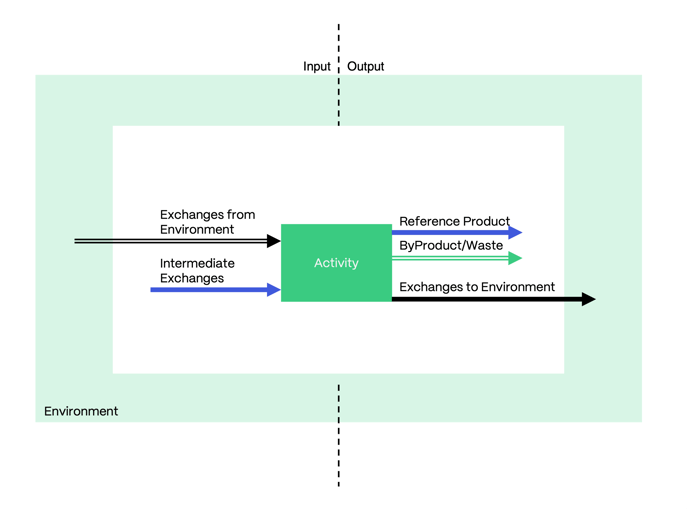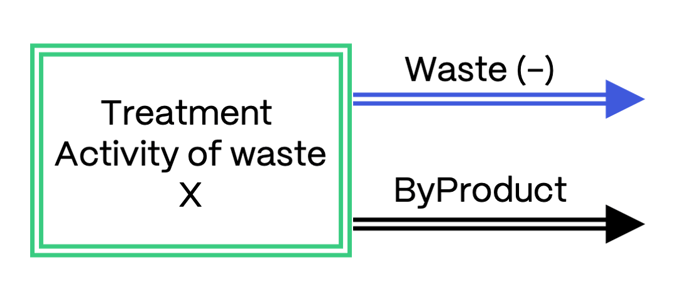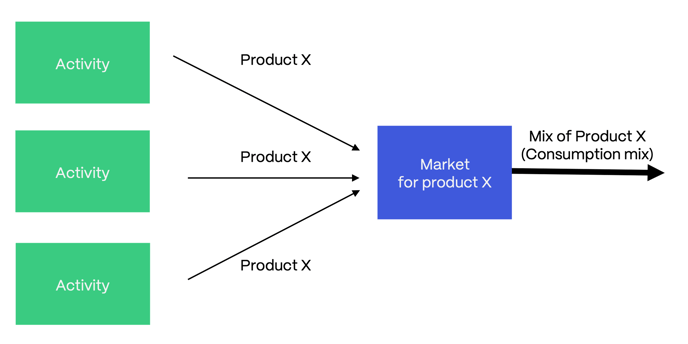Each dataset in the ecoinvent database represents a human activity (process) and its exchanges with the environment and other human activities.
Oct 24th, 2023
Each dataset contains information about:
Its Geography
For example, an activity might be representative of the region of Europe (RER).
Its Time Period
The time period is described as an interval with a start date and an end date. For example, the dataset ‘nitric acid production, product in 50% solution state’ has a time period of 2011-2021.
The time period does not represent an expiring date but the period of original data collection or the period to which the dataset has been extrapolated. A dataset might have an end date that is in the past but is still considered valid today since production processes or technologies did not change or the supply chain was updated.
Its Documentation
The documentation provides a description of what the activity represents, its boundaries, etc.
Its Natural Resource Consumption
For example, the amount of water required to grow 1 kg of cotton.
Its Emission Profile
For example, the amounts of substances emitted to the atmosphere when combusting 1 kg of coal in a coal power plant.
Its Material Flows in and out of the Process, in other Words, its Bill of Materials
For example, the amounts of wood, pulp and various additives needed to produce 1 kg of newspaper.
Its Energy and Fuel Consumption
For example, the amounts and technology mix of electricity used to produce 1 kg of aluminum.
Its Mass, Water, Biogenic and Fossil Carbon Accounts
For example, in a paper production process, how much of the biogenic carbon entering the process in wood inputs ends up in the paper product versus how much is combusted for energy generation and released as CO2 emissions to the atmosphere.
Its Annual Production Volume
For example, the annual production of hard coal in Australian hard coal mines.
Each activity is uniquely identified based on name, geography and time period: geography is a key factor in understanding how datasets interact with each other. This unique combination of name, geography, and time period allows the identification of each undefined dataset by an id number, the so called universal unique identifiers (UUID) number.
Types of Activities
Several types of activities can be distinguished and will be described in more detail below. All activities have exchanges on the input side and on the output side.
 Exchanges from and to the environment, also called elementary exchanges, are placed on the input side when a process consumes natural resources, such as iron ore from the ground, water from a river or CO2 taken up from the air into a tree. Elementary exchanges are placed on the output side when a process releases emissions into soil, water or air.
Exchanges from and to the environment, also called elementary exchanges, are placed on the input side when a process consumes natural resources, such as iron ore from the ground, water from a river or CO2 taken up from the air into a tree. Elementary exchanges are placed on the output side when a process releases emissions into soil, water or air.
All other exchanges are intermediate exchanges, i.e., the products consumed or produced by a process and exchanged with other processes. On the output side, we distinguish between types of products: reference products and by-products or waste.
Ordinary Transforming Activities
All activities that are not of the special types described below are “ordinary” transforming activities. Transforming activities are human activities that transform inputs so that the output of the activity is different from the inputs, e.g., a hard coal mine that extracts hard coal in the ground to deliver the marketable product hard coal.
Treatment Activities
Waste in the ecoinvent database has no economic value and is not sold on the market. Since waste are intermediate exchanges, they cannot be released into the environment; but require treatment processes. Treatment processes (treatment activities) convert:
- a waste into a valuable product, e.g., used cooking oil needs to be purified to become a valuable input to biofuel production. This process can be seen as recycling.
- a waste into emissions to the environment, i.e., elementary exchanges. An example would be the treatment of polluted wastewater to obtain unpolluted water, which is released into a river. This process can be seen as final disposal.
Treatment activities have a negative reference product, e.g., treatment of inert waste in a landfill has a reference product of -1 kg of inert waste.
The negative sign indicates that the treatment activity supplies the service of treating or disposing of its reference product. For example, the treatment of unsorted waste paper by sorting has unsorted waste paper as a negative reference product. Physically, the reference product is an input to the treatment activity, e.g., the unsorted waste paper is an input to the sorting process. However, reference products in ecoinvent datasets are placed on the output side, and they have a negative sign to maintain the mass balance of the process. The by-products of the treatment activity have a positive sign; they represent valuable products obtained after treatment, e.g., the sorted paper leaving the sorting process.

Dedicated treatment activities often carry the name “treatment of … [name of the product to be treated]”. Treatment or disposal of a material is their main purpose.
In general, each treatment activity has only one waste as input (negative reference product).
Furthermore, any transforming activity can function as a treatment activity if one of its inputs is a material for treatment. This case is called speciality production in the ecoinvent database.
Market Activities

Market activities are also called market datasets or simply markets. Market datasets transfer the product output of one or more producing (transforming) activities to activities that consume it as an input, e.g., from hard coal at the supplier to hard coal at the consumer. The geographical boundaries of a market are chosen to reflect real-world trade conditions. For example, hard coal consumers in Australia are primarily supplied by hard coal producers in Australia, justifying an Australian market for hard coal.
Market activities account for transport and losses of the product. They further provide the average consumption mix of a product for a given region and the marginal consumption mix in the consequential system model. Learn more about the markets.
Construction Activities
Infrastructure (i.e., capital goods) in the ecoinvent database is defined as products that have a lifetime that exceeds one year and that are not meant for consumption. This definition includes both stationary infrastructure, such as buildings, electricity or gas grids, roads, rails, mines and production facilities, and mobile infrastructure, such as machinery, tools and vehicles.
An activity producing an immobile infrastructure product often carries the term “construction” in its name. Therefore, these activities are also referred to as construction activities. The reference unit of infrastructure products in the database is most commonly “unit”, e.g., 1 unit of power plant. A construction activity usually covers the initial construction, the maintenance of the infrastructure during its lifetime, the land occupation and land transformation (if applicable) and the decommissioning for waste treatment at the end of the lifetime. The waste streams from decommissioned infrastructure leave the activity as by-product/waste outputs. The mass of the infrastructure thus leaves the construction activity with the waste streams; therefore, infrastructure products are an exception in that they do not come with properties of mass and carbon content.
Instead of mass properties, infrastructure products have properties of “lifetime” and “lifetime capacity”. Read more about these and other product properties here.
Service Activities
Service activities have inputs and outputs required to perform a service on another product, without the actual input and output of the product receiving the service. Services are therefore defined as immaterial exchanges, i.e., without a physical good changing ownership.
For example, the service of sawing with a power saw does not have an input of the tree standing in the forest. Instead, the forestry process has an input of the tree standing in the forest, an input of power sawing (in hours) and an output of the felled tree. The amount of the saw, the fuel to operate it, the lubricating oil to maintain it and the emissions released during operation enter the forestry process indirectly through the service activity.
Operation Activities
Processes with the term “operation” as part of their name represent the use of a specific infrastructure product, e.g., “mine operation” as opposed to “mine construction”. Operation datasets thus always have inputs of infrastructure. The term “operation” is used as a synonym for “use”. The term is applied to both industrial activities, e.g., “gold refinery operation”, and household activities, e.g., “operation, computer, desktop”. Operation activities may also fulfil the criteria to be a service activity.
The reference products of operation activities are not of any special type; they are normal products, such as refined gold resulting from gold refinery operation.
Products
Every human activity represented in the ecoinvent database has an output of one or more products. These products comprise materials, goods and services that become available to other human activities, which use them as inputs and then transform them into yet other products, transfer them to another location, or dispose of them.
The ecoinvent database allows us to follow flows of products within a highly connected network of global supply chains.
Moreover, for every product, the database contains information on:
- the environmental impacts associated with its production, transport, trade or disposal.
- the average price of the product.
- the average physical product properties (for products with mass)
- Dry mass
- Wet mass
- Biogenic and fossil carbon content
- the average consumption mix of a product in a market, i.e., the contribution of different technologies producing the same product for a common end market. For example, the shares of electricity produced from hydro, nuclear, coal, natural gas and wind in a country.
- trade information: the average transport modes and distances between the producers and consumers of the product are modelled within the product’s
Types of Products
Reference Products
The reference product is the driver of a process. It is the product for which a change in demand will affect the production volume of the process (also known as the determining product). The reference product can be a good or a service.
By-Products/Waste
By-products and waste are co-produced together with the reference product but would not justify performing a process for their own sake. For example, straw is produced together with wheat grain, which is the reference product.
In most situations, by-products can easily be distinguished from reference products. Often, by-products are similar to waste and are therefore not even fully utilised, such as straw.
Within the category of by-products/waste, waste does not have an economic value, whereas by-products do have a value on the market.
The distinction between reference products and by-products/waste is process-specific, i.e., the same product can appear as a reference product in one process and as a by-product/waste of another process.
Every intermediate exchange also carries two by-product classifications that are consistent across all the processes in which the exchange appears. The intermediate exchanges are classified as either waste, recyclable, or allocatable product, and as a material for treatment (mft) or not a material for treatment (non-mft). These classifications determine the fate of a by-product within the rules of different system models. You can read more about system models here
